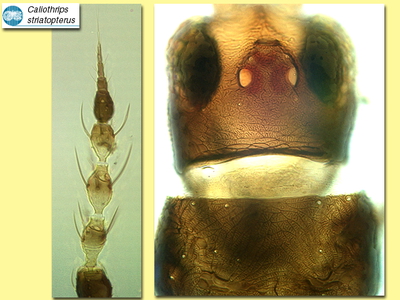Figures
Fig. 1 Antenna, head and pronotum
Fig.2 Fore and hind wing
Fig. 3 Tergite IV and V, sternites (male)
Species
Caliothrips striatopterus KobusBiology
Although adults have been found on various plants this species apparently breeds only on the leaves of grasses.
Distribution
Northern Australia and Indonesia (see comment on related species).
Recognition
Colour brown except: tarsi and apices of tibiae yellow, antennal segments III-V yellow with apices variably brown, forewings with 3 transverse pale bands - sub-basally, sub-apically and at extreme apex. Head not constricted into a basal neck, dorsal surface with complex sculpture medially comprising many fine lines within ill-defined reticles. Antennae with 8 segments, III & IV constricted into a neck at base and apex, each bearing a long forked sense cone; VIII almost as long as VI+VII. Pronotum with oblique linear reticulation and many fine lines within each reticle. Metathoracic endofurca elongate and lyre-shaped. Forewing first vein with about 5 setae basally and 2 setae near apex; second vein with about 7 setae. Tarsi all 1-segmented. Abdominal tergites II-VIII laterally with many transverse lines or narrow reticles but with no sculpture between these lines; VIII posterior margin with a craspedum medially but a few teeth laterally. Male smaller than female with slender abdomen, sternites III-VII with slender, curved transverse glandular area; tergite IX with one pair of stout thorn-like setae medially, with 2 pairs of more slender setae behind.
Related species
This species closely resembles C. luckmanni from India and C. sudanensis from Africa in sculpture and in having the extreme apex of the forewing pale not shaded (Wilson 1975). The recorded differences between C. sudanensis and C. striatopterus are not reliable, although the Australian specimens have the base of the hind tibiae darker.




